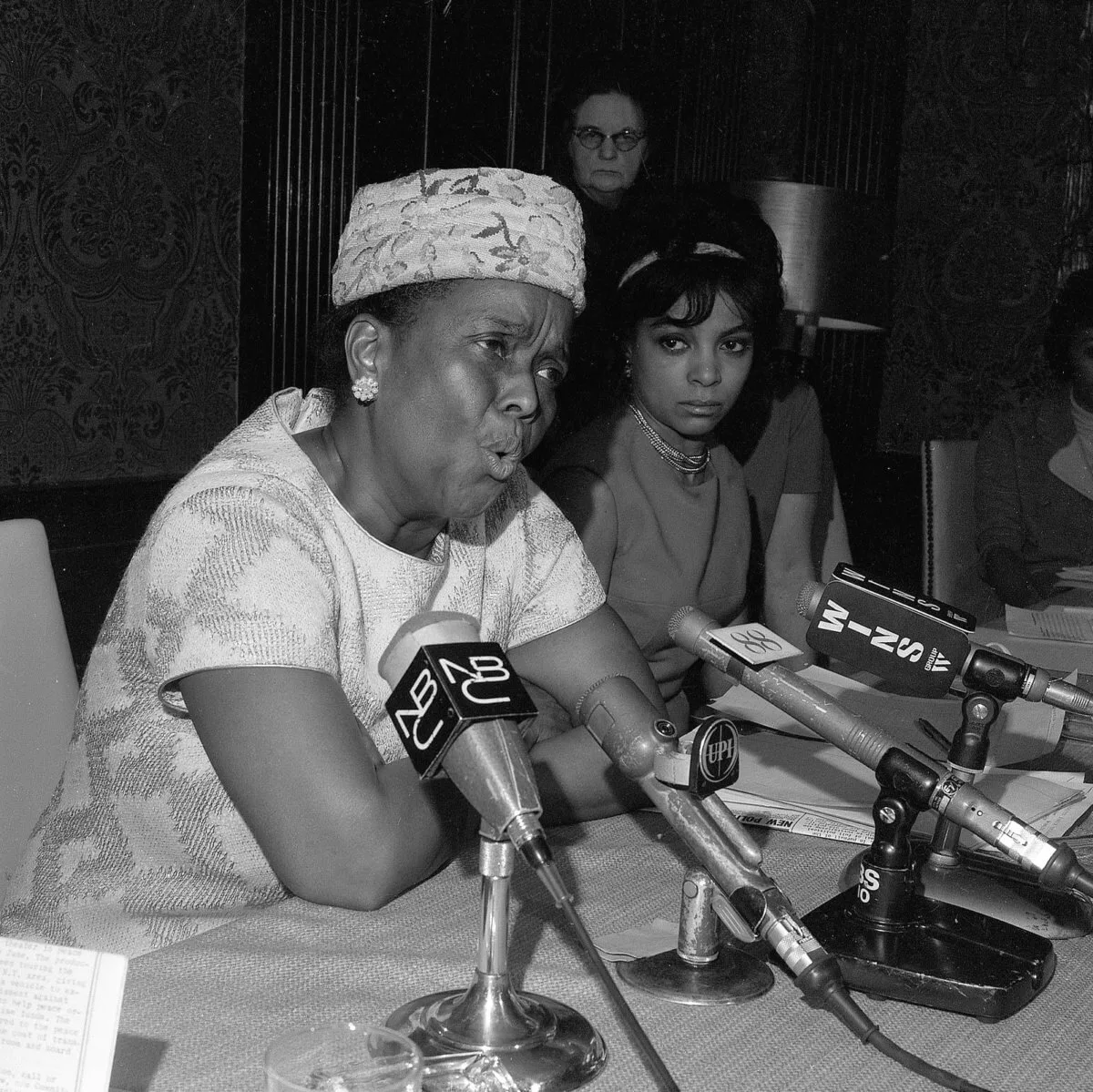
Civil rights visionary Ella Baker, who grew up in eastern North Carolina, at a 1968 news conference. (AP Photo/Jack Harris)
North Carolina history is rich, but neglecting Black perspectives renders it flat. Bring history to life with an east-to-west road trip that travels from the coastal maroon colonies to the founding of the sit-in movement to the site of MLK’s address in Durham.
The Civil Rights Movement is not one moment in time. It’s not one place or person. It’s not one ethos or organization.
It is a constellation — luminous points stretching into today. And many of those points are in North Carolina.
It might be several young folks cooling off with ice cream and milkshakes in Durham. Or two siblings taking action against the injustice of Jim Crow literacy tests in tiny Roper, N.C. It could be a Black resort on coastal Shell Island where folks went simply to relax, at a time when so many things were denied to Black Americans. That includes the small decencies, like a comfortable space to kick back.
We know North Carolina. Subscribe to the free Cardinal & Pine newsletter.
This Black History Month, we wanted to help you find some of those points on the map and, if you’re ready for the pilgrimage, take a trip from the coast to the mountains to mourn, commune, or celebrate.
This list is by no means comprehensive. Some of the suggestions are well-known with a museum on-site. Others may have nothing left but a field or housing development. Many of these destinations are in small coastal and eastern communities where so many Black North Carolinians lived, led, and died.
What does remain, the constant, is the work that was done and the change it left behind.
Maroon Colonies of the Great Dismal Swamp – Northeast North Carolina
This mystery is no longer a mystery.
Formerly unsubstantiated tales of maroon colonies have always circulated around the Great Dismal Swamp. We now have proof that thousands of enslaved people took freedom in their own hands, escaping their captors and settling into hard-won communities in the massive swampland stretching about a million acres from northeast North Carolina into southeastern Virginia.
Between the snakes, insects, and difficult farming conditions, life must have been hard, but imminently preferable to the savagery of slavery.
Inhabitants farmed and lived on natural resources, trading with and defending their territory against whites in neighboring areas. Archaeologists say that thousands might have occupied the swamps from 1700 until the Civil War, with maroon settlers joining the Union war effort or moving out after the conclusion of the war.
Harriet Beecher Stowe, author of “Uncle Tom’s Cabin,” focused on them in her second book, “Dred: A Tale of the Great Dismal Swamp.”
Today these sparse lands remain inhospitable, but retain a sparse, singular beauty. Start here — in Gates, Camden, and Pasquotank counties — and then head west.
Harriet Jacobs Trail – Edenton
Outraged by attempts to portray slavery as idyllic or genteel, Edenton native Harriet Jacobs risked her life and freedom to show the world the ugly truth of life under bondage for Black women.
Jacobs’ 1861 book “Incidents in the Life of a Slave Girl” is a classic. Written under a pseudonym with fictional names for real people, it captured the near-constant danger for Black Americans even after they escaped slavery, especially for Black mothers often separated from their children.
After fleeing the South, Jacobs became an internationally-known advocate for abolition, feminism, and education, eventually founding a school for Black folks in Union-occupied Alexandria, Virginia, in 1864. She continued to be an advocate for education and civil rights through Reconstruction.
The eastern North Carolina town of Edenton where she was born hosts an exhibit and tour telling Jacobs’ story.
Ella Baker’s Rise – Littleton – Raleigh, N.C.
Rural Halifax County, which gave the world civil rights icon Ella Baker, is still at the center of a decades-old, unresolved lawsuit over educational inequalities.
Like many Black women of the mid-20th century, Baker didn’t have the spotlight of the giants she worked closely with, figures like Martin Luther King Jr., W.E.B. DuBois, and Thurgood Marshall, but she was a fierce critic of racism and sexism for five decades.
Among her most significant contributions was her formative role in the youth-led Student Nonviolent Coordinating Committee (SNCC) at Shaw University, the historically Black college in Raleigh where Baker studied.
SNCC led the student-led sit-in movement of the 1960s, which had its most visible moment at a Greensboro Woolworth’s in February 1960. Today, that’s the site of the International Civil Rights Center & Museum.
Baker is a giant. Take a trip to her Halifax hometown and then steer southwest for Shaw University.
MLK Fires Up the Sit-in Movement – Durham

Durham is a remarkable destination for Black history. The old tobacco city is home to N.C. Central University, which became the first state-backed liberal arts school for Black students in the nation when it was absorbed into the state system in 1923. Durham was also home to a thriving Black entrepreneurial class in the early 20th century.
It remained a hub for Southern Black leadership into the 1960s, when Martin Luther King Jr. came to Durham’s White Rock Baptist Church 15 days after the Greensboro sit-in began. There, Dr. King toured local businesses closed by the blooming sit-in demonstrations and that night at the church, which still stands today, King lauded the “creative protest” of sit-in leaders.
“Let us not fear going to jail,” King said in his address. “If the officials threaten to arrest us for standing up for our rights, we must answer by saying that we are willing and prepared to fill up the jails of the South.”
The Union of Racial Justice and Workers’ Rights – Winston-Salem

Tobacco was at the convergence of North Carolina culture and commerce for generations. And in the 1940s, it marked a convergence of labor rights and racial justice.
Union demonstrators of the era explicitly linked the struggle for civil rights with workers’ plight at R.J. Reynolds, one of the most dominant tobacco companies of the 20th century. Black women led the strike, which ultimately yielded wage increases, improved job security, and worker protections.
Like so many of the sprawling tobacco warehouses of the era, it still stands today.
YMI Cultural Center – Asheville
Still have gas in the tank? Let’s head to the mountains.
The YMI Cultural Center in Asheville is a must-see. Founded at the end of the 19th century by local Black leaders, the Young Men’s Institute was envisioned as a Black YMCA for workers building the nearby Biltmore Mansion.
Today, the center remains a local landmark that leads business incubation, workforce development, youth advancement, and local exercise programs.
Politics

VIDEO: Senate Republicans Block Bill to Extend Child Tax Credit
View this post on Instagram A post shared by Cardinal & Pine (@cardinalandpine) Monday was tax day, and Senate Republicans are...

NC’s Congressional Democrats urge House to protect IVF
Any Republican serious about protecting IVF needs to put their votes where their mouth is, the Democrats wrote to House leadership. After the...
Local News

The zodiac signs of 12 iconic women offer insight into their historic accomplishments
Zodiac signs can tell you a lot about someone’s personality. Whether they’re an earth, water, air, or fire sign, these 12 categories (which are...

VIDEO: Two men rescued off Beaufort, NC
https://www.tiktok.com/@cardinalandpine/video/7353300192906562859?lang=en WATCH: We love our Coasties in NC! ⚓️ When a boat ran aground off of...





